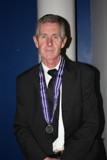
“The Greeks and Romans had many gods but hydrologists have many models,” quipped the director of the Institute for Water Research (IWR), Professor Denis Hughes during his address marking his reception of the Vice-Chancellor’s Distinguished Researcher’s Award recently.
A renowned hydrologist, respected supervisor and an expert in the field of rainfall-runoff models, Prof Hughes presented a lecture entitled: “Modelling hydrology and water resources: science, engineering, art or religion?”.
He looked at all the different approaches to understanding our complex hydrological systems through his research as director of IWR.
Using a diagram to illustrate how we need to look at the basic level of water resources and how society and the economy affect hydrological systems, he quoted William Dewing who said “In God we trust, all others must bring data”.
Along the same lines was Lord Kelvin, who said that if you can’t express it in numbers, it’s isn’t much use, which applies to the complexities of the relationship between surface water and groundwater.
The question of how much rain is needed to generate runoff is not easily answered, so we need measurements or estimations, which is where hydrological models (HMs) comes in handy.
“The most important things can’t be measured, so we would like to at least extrapolate the knowns from the unknowns generating ‘useful’ information in the absence of ‘hard’ data,” says Prof Hughes. “But how do we do this in a world that is naturally complex, difficult to measure and where human interference adds much more complexity?”
Because many catchments are not measured, HMs are used to estimate the availability of water resources or the quality of water. They are also used to test hypotheses of process understanding and predict the future and provide estimates of future water availability under different scenarios.
An HM is a representation of what goes on within a landscape involving water, typically implemented as a computer model. “Almost all types of scientists get involved with HMs, which often affects their approaches,” says Prof Hughes, joking how, for example, computer scientists “like fancy graphics and lots of buttons and prefer the model to be web-based”.
By making similar comparisons to how engineers, physicists and artists would approach HMs, he cleverly interwove recent findings with examples of how HMs can be used. In using the comparison of how model user group meetings are similar to evangelical prayer meetings, he jokes “The model developers are the high priests or priestesses.
The users are the disciples and adherents who express faith (often blindly) in their beliefs of the superiority of their chosen model.”However “We also have model ‘atheists’ who vehemently declare all models to be mere imaginations of the human psyche and not connected with reality.”
“Among the key questions is whether HMs give the right answers for the right reasons. But do we know enough about the world to know the right answer or the right reason? It is these questions that dominate both science and the scientific literature.”
“Models should be useful tools that are a means to an end and should not be seen as the end themselves,” he said, before showcasing some of the research being conducted by his colleagues and students, who use a model application software framework called SPATSIM that was developed by Prof Hughes and David Forsyth of the IWR.
Photo and story by Anna-Karien Otto
